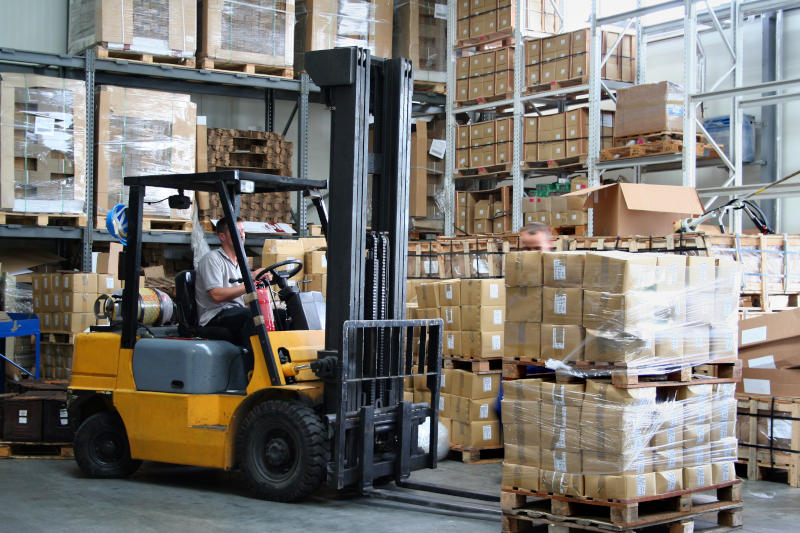October 4, 2021
POST AT A GLANCE
- A Google survey found that 42% of B2B decision makers use a mobile device to conduct research for buying.
- Another report found that 73% of B2B buyers are now Millennials.
- A Forrester Research study found in January 2019 that B2B e-commerce “will reach $1.8 trillion and account for 17% of all B2B sales in the U.S. by 2023.”
How to Choose the Best Ecommerce Platform for Distributors
Yes, distributors and B2B companies, Amazon-type marketplaces exist for your products! That’s wonderful news, because B2B customers are becoming more like B2C customers everyday.
You already know that Amazon dominates the B2C e-commerce world, but did you know that there are a handful of e-commerce platforms that work great selling industrial products online with your own e-commerce website. Many of them offer the same great features as Amazon!
With this capability, distributors can give B2B buyers what they’ve come to expect -- an automated buying experience, rapid response times and websites that provide an easy mobile experience.
All of these are possible with an e-commerce website, but not all marketplaces are created equal. E-commerce sites can be extremely beneficial to your company, and also deliver the buying experience that your customers are coming to expect.
Why Should Distributors Have an E-commerce Website?
True or false: It’s best to meet your customers where they are.
In exceedingly general terms the answer is “true,” as customers cannot buy what they cannot find. That’s why distributors and other B2B companies set up booths at trade shows, wined and dined their clients and engaged in traditional marketing tactics to fill their sales funnels.
But with the outbreak of Covid-19, all of those methods of client outreach -- meeting your clients where they are -- went out the proverbial window. The world is slowly but surely recovering from the Covid pandemic, but the habits of B2B buyers have changed forever, and now it’s time to rethink old methods and find out where your clients are so you can meet them there.
B2B customers are using their mobile phones for research
One habit of B2B customers that has been increasing over the years is their use of mobile phones. This is not a surprise to anyone, as smart phones have become an integral part of our lives.
But what has changed is their usage by B2B decision makers for their buying process. A recent Google survey found that 42% of B2B decision makers use a mobile device to do at least some of their online research.
So not only do distributors need to have an online presence, but they also need to have mobile friendly websites and content. Otherwise, your customers will be happy to learn about they products they need from your competitors.

Millennials are becoming the new B2B buyers
As time passes, the generations that are empowered to make high-level decisions must pass the torch at some point to keep the flame alive. This is happening in droves, as research indicates that an amazing 73% of B2B buyers are now millennials.
In the same survey, it was found that not only are 44% of Millenials who engage in B2B buying decisions making purchasing decisions, but 33% of company key influencers for buying decisions are millennials as well.
The overwhelming majority of millennials have grown up in a connected world where the web is not only a source of information, but a virtual shopping mall as well. Nearly two-thirds of millennial B2B buying decision makers greatly prefer a unique buying experience. This presents a great opportunity for e-commerce
E-commerce is looking up for B2B distributors
So your customers prefer to use their mobile devices and the web to make purchases, but what about the state of e-commerce on it’s own?
Well, the data on this distribution channel has been available for a while, and projections for the future indicate that e-commerce is becoming enormous.
A Forrester Research study all the way back in January of 2019 projected that by 2023, e-commerce sales for B2B companies will amount to $1.8 trillion, equating to 17% of all B2B sales. This projection came well before the pandemic, and in all likelihood needs to be adjusted for an even bigger margin of e-commerce sales.
What Makes A Good Distributor E-commerce Website?
In demonstrating the need for e-commerce by distributors, it’s important to note that your customers are expecting a lot more than something generic. Remember, 60% of millennial B2B buyers prefer a “unique buyer” experience, and given their experience on the web, they’ll be turned off if you don’t check the right boxes on your e-commerce website.
What follows can be accomplished by building an in-house team with workers that can handle each vertical within the e-commerce channel, or distributors can employ a digital marketing agency that has experience building and optimizing e-commerce websites.
Good design is important for your e-commerce website
Fortunately, there are several pre-built websites themes and templates, and several platforms that support building an e-commerce website. This is fine for a distributor to accomplish in-house, but don’t forget that once a website is built, the job is only half-over. Optimizing is a step that many distributors forget, and that’s where they fall down.
A designer for an e-commerce website should have experience not only in creating wireframes and mockups for desktop sites, but also for mobile. Mobile is so important, it should be brought up in every facet of creating an e-commerce website.
Your Distributor Ecommerce Website Needs To Have A Good User Experience (UX)
User experience is something that many take for granted, but when websites don’t work right, what’s your reaction? For many, the answer is simply to leave, and that’s exactly what you want to prevent with your UX.
User experience for e-commerce means easy-to-use, as in simple navigation through the website, having information available, and a smooth buying experience. Part of this is making sure that your website loads fast, as any delays will lead to a poor customer experience.

But again, it’s not enough to build the website perfectly and then expect it to run that way until the end of time. E-commerce websites need to be optimized for mobile, and the site itself needs to be constantly optimized as well.
Using core Key Performance Indicators (KPIs) such as time on page and bounce rate, you can see for yourself how easy it is for customers to navigate the website, and what pages are causing them to leave.
That means constant attention to detail, and many tweaks on the website to keep things running smoothly, and to see constant improvement. And of course, anytime a website is optimized, it will also have to be optimized for mobile use as well.
Distributors Need Mobile Friendly Websites
Did we mention that mobile friendly is important for your e-commerce website? Good, you’ve been paying attention, and that’s important, as mobile and tablet usage surpassed desktop internet usage all the way back in October 2016.
Inventory Management is Critical for Distributors
Inventory tracking systems have been popular for a long time, and given that many distributors have hundreds of thousands or even millions of SKUs. However, when coupled with e-commerce, it’s important to think of inventory management as just one step in a process that occurs post-sale.
In the past, if a customer bought a product, your sellers would already have a process in place to up-sell, cross-sell and provide customer service to keep the relationship alive.
This process is still possible, and in fact, it’s gotten so streamlined that it can be entirely automated.
Then, the post-sale phase of inventory management, customer service, up-selling, cross-selling, and ongoing customer success. Integrating this software can be a bit tricky, as it’s essential to not only provide a good UX experience, but also important in keeping your customers close to home.
Search Engine Optimization (SEO) Helps Customers Find You In Search Engines
If inventory management, and all that comes with it, is part of the post-sale process, then SEO and content marketing are part of the pre-sale process. Good SEO on your distributor website is an integral part of lead nurturing for e-commerce, and selling on your website will be extremely difficult without it.
Imagine the cadence of your sales funnel in the e-commerce world, and start at the top. How are potential customers finding you?
Well, the answer has already been discussed -- they’re using their mobile devices, and to some degree their desktops or laptops, to scour the web for sources of truth.
Distributors are facing a more intelligent and informed buyer than B2C customers, and therefore, the need to produce thought-provoking and ultimately helpful content is even more pronounced.
SEO and content marketing is the process of your company creating blog articles, infographics, and videos, for example, that help educate potential customers about the industry and your products.
If they find these sources of truth that help answer their questions, they will likely seek you out for their purchase, as it’s been found that “trust strengthens the positive effect of the B2B parasocial relationship.”
Choosing the Right Platform for Your E-commerce Website
Now that you know the reasons for having an e-commerce website, and what you need to make it successful, it’s time to choose which platform works best for you. Not all e-commerce platforms are created equally, so we’ve chosen the top four to dissect the pros and the cons.

Using Shopify for your Distributor Ecommerce Website
Shopify for distributors is one of the most popular e-commerce platforms for a reason, as it’s easy-to-use and reliable. A major pro for using Shopify is that they have 24/7 customer support, which is important, because your website will be operating within those hours.
Shopify is customizable, offering distributors dozens of different themes to suit their company. It’s also mobile friendly, in that any change made to the desktop platform will automatically update mobile settings. That’s huge!
However, Shopify doesn’t create the best experience for either the back end developer or the customer. It takes a person who’s great with coding to unlock the best features that Shopify has to offer. And these features cost a lot of money too, at least when compared to other platforms.
WordPress + WooCommerce: Pros and Cons for Distributors
WordPress is mostly known as a popular Content Management System (CMS), so they built a separate platform for e-commerce that’s called WooCommerce. WooCommerce is popular with small and medium sized businesses because it’s easy-to-use, and it’s free.
WooCommerce is even more customizable than Shopify, as there aren’t any themes to choose from because you create your own. It’s also great for optimizing your core KPIs, as it is compatible with a plethora of plugins, such as ones that manage your customer navigation, shopping cart and their checkout experience.
The cons of WooCommerce are almost a result of pros, as it aims to be easy, and so easy that it can’t perform too many complex functions. It also requires constant updates to remain mobile friendly, so developers are going to have to give it constant attention. And if the plugins, while great, become too many, it will affect the function of your website in a negative way.
BigCommerce For Distributor Websites
BigCommerce is another e-commerce platform that has several pros and cons. Like Shopify, users of BigCommerce love the back end support, as customer service is a staple of their product. It’s also easy to use and there aren’t any transaction fees.
BigCommerce is also known as a highly reliable website where loading speed is a constant. It’s also great for any sized company, as it’s scalable, and very easy to add more SKUs.
The problem with BigCommerce is that customers have trouble optimizing content that’s already loaded onto the website. BigCommerce is also highly regarded as one of the most expensive e-commerce platforms, as while transaction fees are waived, they make up for it with charges at various other points on the road.
Magento Pros and Cons
Magento Commerce is an e-commerce platform that is considered great for larger businesses. The reason is because it’s not only scalable, but it also enables businesses to build out multiple stores, or create other stores for different warehouses.
Magento Commerce also offers businesses many of the things you want in an e-commerce platform, such as fast loading times, simplified data management, and is highly customizable.
Where Magento Commerce falls down is in the fact that it too is pricey. Not only that, but while Magento Commerce features a robust team of developers, finding one that is qualified to solve your problem is not very promising.
Final Thoughts
So there you have it, the reasons behind creating an e-commerce platform, what you need to have success, and who to use to make it happen. One thing that should be noted is that the above e-commerce platforms also work in conjunction with brick-and-mortar stores.
We only bring that up because e-commerce has been around for long enough that B2B platforms have realized the struggles of converting distributors from their original sales funnels to a new digital one. Inventories from all of your locations can be tracked with your new, online store.
After all, the data doesn’t support the conclusion that e-commerce will amount to 100% of sales in the future, but a sales channel with so much upside cannot be ignored. Lest the competition adopt something that you don’t, and build trust with future customers where they are -- online.



Share:
Social Media for Manufacturers: Strategies For Your B2B Social Media Marketing
Top B2B Marketing Statistics to Boost Sales in 2022